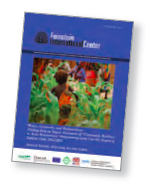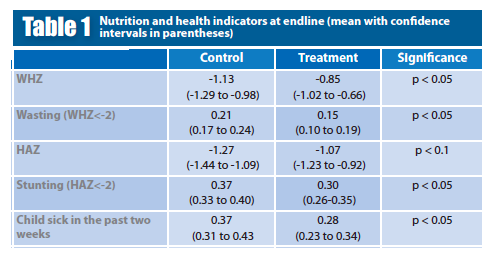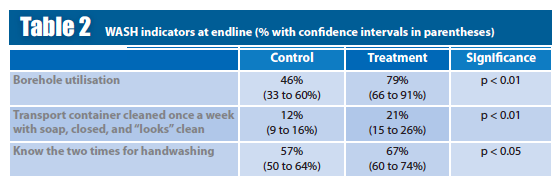Water, livestock, and malnutrition findings from an impact assessment of Community Resilience to Acute Malnutrition programme in Chad
Summary of conference abstract and report
By Anastasia Marshak, Helen Young and Anne Radday
Presented at the ACF research conference, November 9th, 2016. Full report: Anastasia Marshak, Helen Young and Anne Radday. Water, Livestock, and Malnutrition. Findings from an Impact Assessment of Community Resilience to Acute Malnutrition Programming in the Dar Sila Region of Eastern Chad, 2012-2015. Feinstein International Center, December, 2016. http://fic.tufts.edu/publications/
Anastasia Marshak is a Researcher at the Feinstein International Center, Friedman School of Nutrition Science and Policy, Tufts University. Helen Young is Research Director at the Feinstein International Centre, Friedman School of Nutrition Science and Policy, Tufts University. Anne Radday is Research Programme Manager at the Feinstein International Center, Friedman School of Nutrition Science and Policy, Tufts University.
Video footage of the conference presentation is available here.
Location: Chad
What we know: Evidence and mechanisms of impact are limited regarding programmes that combine nutrition with other interventions, such as health, water, sanitation and hygiene (WASH) and food security.
What this article adds: A randomised control trial impact evaluation was conducted of the Community Resilience to Acute Malnutrition (CRAM) project in Chad, a three-year, integrated, multi-sector programme. The findings indicate significant programme impact, particularly in relation to acute malnutrition, although prevalence of wasting (and stunting) remained high.
At endline, children in CRAM settlements were significantly better off, including lower prevalence of wasting, stunting and illness. WASH promotion activities also showed a significant positive impact of CRAM and were correlated to child nutrition outcomes. Differences in child outcomes between settled and former pastoralist communities may be explained by seasonal factors and livestock management practices affecting water contamination by cattle. This suggests access to clean water is not sufficient; hygiene of the supply chain also appears critical.
 The Dar Sila region of eastern Chad experiences highly variable rainfall, seasonal food insecurity and high prevalence of acute malnutrition. In 2012, Concern Worldwide put in place an integrated programme that combines nutrition, health, water, sanitation and hygiene (WASH) and food, income and markets (FIM) provision in Dar Sila called Community Resilience to Acute Malnutrition (CRAM). The programme was designed to reduce child acute malnutrition in the face of seasonal shocks.
The Dar Sila region of eastern Chad experiences highly variable rainfall, seasonal food insecurity and high prevalence of acute malnutrition. In 2012, Concern Worldwide put in place an integrated programme that combines nutrition, health, water, sanitation and hygiene (WASH) and food, income and markets (FIM) provision in Dar Sila called Community Resilience to Acute Malnutrition (CRAM). The programme was designed to reduce child acute malnutrition in the face of seasonal shocks.
Concern collaborated with the Feinstein International Center, Friedman School of Nutrition Science and Policy at Tufts University to carry out a randomised control trial impact evaluation to better understand the level of programme impact and the mechanisms behind it. Three surveys took place in November and December of 2012, 2014 and 2015 in 69 settlements encompassed by the Concern programme area. This article summarises the impact of the CRAM programme and highlights household and community characteristics correlated with acute malnutrition in Dar Sila, Chad.
Method
The study covered 1,400 households, spread evenly between 69 settlements. The survey collected information on household demographics, socio-economic characteristics, food insecurity, access to natural resources, and child nutrition and morbidity. In addition, a qualitative investigation was carried out in 2013, 2015, and 2016 using focus groups and key informant interviews.
All the data were adjusted for the sampling design and included population weights. To establish programme impact, logit and ordinary least squares (OLS) analysis regression models were used for binary and continuous outcome variables respectively. To take advantage of the panel nature of the dataset, a random and fixed effects model was run using the weight-for-height z-score (WHZ) of the child in the household with the lowest score as the outcome variable, simply referred to as ‘nutritional status’.
Results
At the endline, children in the CRAM settlements performed significantly better than the non-intervention group on a host of key nutrition and health indicators. They had lower prevalence of wasting; higher WHZ; lower prevalence of chronic malnutrition (stunting); higher height-for-age z-scores (HAZ); and lower prevalence of illness (Table 1). Even when controlling for child, household and settlement characteristics using a random and fixed effects regression model, both being in the intervention group (p<0.1) and moving from not receiving CRAM to receiving CRAM (p<0.1) was significantly correlated to better household child nutritional status (i.e. minimum household WHZ).

The WASH promotion activities also showed a significant positive impact of CRAM and were correlated to child nutrition outcomes, specifically in relation to the following variables: greater utilisation of boreholes; greater reports of regularly washing the transport and storage container with soap; and greater knowledge around the two main times for handwashing (Table 2). However, the proportion of respondent’s correctly practicing handwashing significantly decreased (p < 0.05) in the intervention settlements only, suggesting increased knowledge did not translate into changes in behaviour. A link was observed between water consumption and CRAM in relation to exclusive breastfeeding. Respondents in the intervention settlement were significantly more likely to exclusively breastfeed at the endline, primarily driven by a reduction in giving water to children under the age of six months (78% of mothers reported giving water in the non-intervention settlements versus 54% in the intervention settlements (p < .05)). In the regression analysis, utilisation of a borehole (as opposed to an open water source) was significantly (p<0.01) and negatively correlated with child acute malnutrition. However, the same relationship was not observed in the non-intervention settlements, indicating a potential role for hygiene practices along the water chain in reducing contamination of water.

A possible source of water contamination is the concentration of cattle in a village. In the regression analysis, while individual livestock ownership correlated with better child nutrition outcomes (p<0.1), as the concentration of cattle in a village increases, so do rates of acute malnutrition (p<0.05). However, children who lived in former pastoralist settlements had consistently better nutritional status (p<0.05), even though households in these settlements were significantly more likely to own more cattle (p<0.01). Differences in livestock management and seasonal location of livestock, uncovered in the qualitative research, may be driving this observed difference in child nutrition outcomes. Households in the former pastoralist damre communities, specialised in cattle production, reported migrating farther with their herds during the dry season to areas with permanent rivers. Village households brought their cattle back to the village at the height of the dry season and utilised nearby water sources, including the borehole.
Discussion
These findings indicate significant programme impact, particularly in relation to acute malnutrition. One cautionary note is that, for the duration of the programme, the prevalence of global acute malnutrition remained around 15% or above, while stunting prevalence was between 30 and 45%. There is no statistical evidence that CRAM reduced the rate of malnutrition in the intervention settlements; rather, unlike in the non-intervention settlements, malnutrition rates did not increase over time. These continuing high rates of acute malnutrition, and the increases seen in the non-intervention settlements, are causes for concern and indicative of the extreme vulnerability of these communities as they emerge from more than a decade of protracted crises. There is, however, greater resilience in CRAM settlements as a result of the programme.
The data also offer clues regarding the mechanisms related to impact and how impact could be increased. Using a borehole without proper training on the water chain does not in itself significantly decrease rates of malnutrition. Routine water testing found that, while contamination levels (coliforms) of borehole water at the point of collection were low to non-existent, they increased at certain points along the water chain (from borehole to transport container to storage container). This finding suggests that the positive impact of CRAM on malnutrition may be via the WASH activities that are focused on reducing the risk of contamination of potable water further along the water chain. These activities promote good hygiene in relation to water containers.
A possible source of water contamination is the concentration of cattle in a village. The association between village cattle density and child nutritional status is a possible explanation of contamination. Previous literature had identified several pathogens associated with diarrhoea and death among infants. One of those pathogens – cryptosporidium parvum – is water-borne, is passed from cattle to humans, and has been to shown to cause rather than simply exacerbate malnutrition.
These findings indicate that CRAM had a significant programme impact on both acute and chronic malnutrition. The evaluation also explored why the CRAM programme might have worked and how it could be improved. Access to clean water appears to play an important although not sufficient role; hygiene practices along the water chain might also be critical in preventing contamination along the water chain.
For more information, contact: Anastasia Marshak. anastasia.marshak@tufts.edu
1Presented at the ACF research conference, November 9th, 2016. Full report: Anastasia Marshak, Helen Young and Anne Radday. Water, Livestock, and Malnutrition. Findings from an Impact Assessment of Community Resilience to Acute Malnutrition Programming in the Dar Sila Region of Eastern Chad, 2012-2015. Feinstein International Center, December, 2016. http://fic.tufts.edu/publications/

